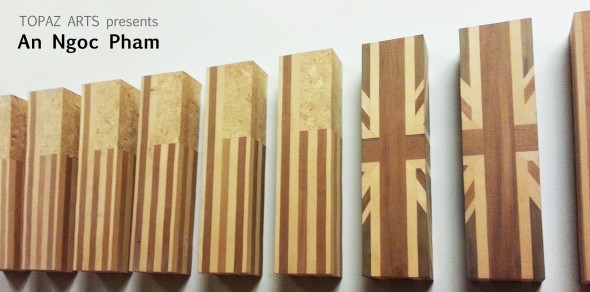
TOPAZ ARTS Visual Arts Program presents Past Present: Resurfacing
a solo exhibition of woodwork, sculpture and painting by An Ngoc Pham
June 14 extended to November 1, 2014
showing by appointment: please email visit@topazarts.org
Special Event!
Sat, Sept 27, 2014 at 2:00pm
Artist Talk with An Ngoc Pham in conversation with Chuong-Dai Vo
Join the artist in conversation with visiting curator Chuong-Dai Vo as they discuss Pham’s life and work.
TOPAZ ARTS Gallery
55-03 39th Avenue, Woodside, NY
directions >
TOPAZ ARTS is pleased to present in its newly expanded gallery space a solo exhibition by NYC-based Vietnamese-American artist An Ngoc Pham featuring woodwork, sculpture and painting. Viewing hours are by appointment please email visit@topazarts.org.
Past Present: Resurfacing features An Ngoc Pham’s body of work, surveying a 25-year span of works created in New York City. An Pham’s newest series, primarily in woodwork and sculpture, include “Flags” (2014) and “Shadow on the Great Hall of the People” (2012). Earlier works in oil painting “Sister’s Life” (1991) and light sculpture “Christmas in the Time of War” (1999) were originally shown in the 1990s as part of Asian-American arts activists known as Godzilla and in group shows alongside other Vietnamese artists. An Pham’s precise works are ingrained with his views and recollections of growing up in a war-torn country. Honing his skills working as a carpenter for over 25 years and influenced as an artist assistant to sculptors such as the late Richard Artschwager and Dan Flavin, An Pham’s precise works are ingrained with his views and recollections of growing up during the war in Vietnam.
“Carpentry solidifies the hand and the mind to create a work of art. My art is a representation of my political views and my understanding of life.” – An Ngoc Pham
The Past is a Journey
by Chương-Đài Võ
An Ngọc Phạm grew up in Biên Hòa, near a major military air base during the Vietnam War. He heard artillery fire on a daily basis. When the sounds ceased in 1975, the silence was disquieting and he could not sleep.
He escaped from the country as a boat refugee in 1979, and settled in New York City. He left with his sister, but somewhere across the ocean she died.
He has returned to Vietnam twice to visit family. The past is a difficult journey.
Previously trained in ceramics at Cao Đẳng Mỹ Thuật Trang Trí Đồng Nai [Dong Nai College of Art and Design], Phạm studied painting at Pratt Institute and honed his carpentry skills working for artists such as Richard Artschwager, Donald Judd and Dan Flavin.
For his solo exhibition at TOPAZ ARTS, Phạm presents nine paintings and sculptures from the 1990s and 2010s. A retrospective spanning twenty-five years, the exhibition showcases his mastery of wood as material and subject—as a metonymy for Vietnam’s long history of colonialism, war and hybrid influences. His use of wood is also a subtle appropriation of minimalism as a language with which to critique American and European power, as manifested in the politics of war and contemporary art.
The early oil paintings show the influence of Vietnamese expressionism in the flattening of space, the decorative patterns and the figurative representations. While the repetition of the lotus in “Floating World” (1992) creates an idyllic, otherworldly landscape, the repetition of camouflage foliage in “Sister’s Life” (1991) alludes to the destructive costs of war borne by civilians, in this case the millions of women who became sex workers during and after the war.
Phạm set “Sister’s Life” in a new bamboo frame, connecting it visually to the more recent bas relief sculptures that are shaped like paintings. As a narrative device in the exhibition, the frame provides a motif with which we can trace the paths of material and socio-political histories that the artist engages with.
Repetition creates a mediating element, a stable entryway through which the artist explores the violence of war. The U.S.-led invasions of Afghanistan and Iraq are the subject of “Flags” (2009-2014), which comprises twenty-two rectangular wooden sculptures lined up like soldiers. The sculptures of U.S. and British flags look like the military coffins that bear the bodies of soldiers killed at war, the coffins that the U.S. government no longer permits news outlets to show back home. While the clean lines and repetition of form point to the strong influence of minimalism, the seemingly faded palette and common woods gesture toward the decline of U.S. power—in international politics and contemporary art. Whereas Judd was criticized for not engaging with the U.S. involvement in Vietnam, Phạm comments on its recurring imperial logic in the Middle East.
Wood as a witness to centuries of Chinese and French history in Vietnam is the subject of “Shadow on the Great Hall of the People (2012) and “Indochine Chair” (2012-2013). Commonplace pieces of furniture, the chairs reveal the imprint of colonial invasions in the curved back, the armrests and the Chinese characters. As with the other works, these bas relief, painting-like sculptures remind us that art and its materials come out of a long history of conquest as well as innovation and renewal.